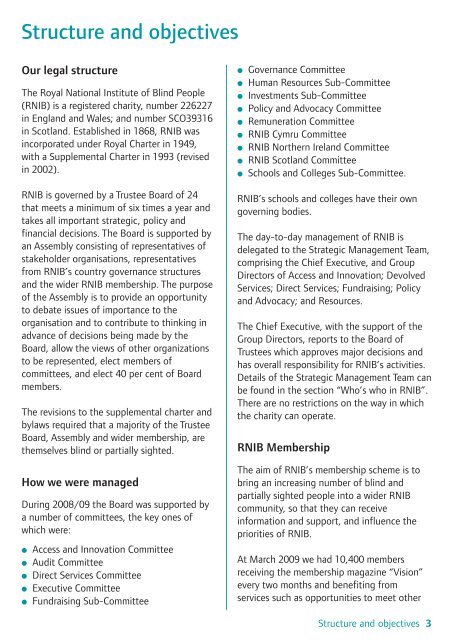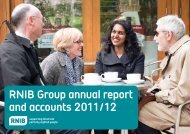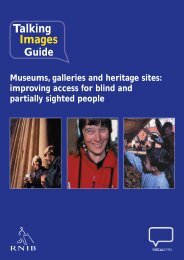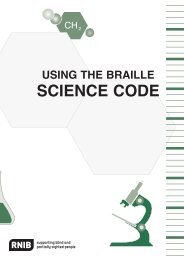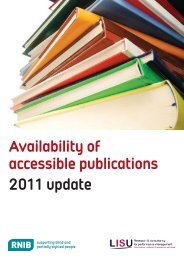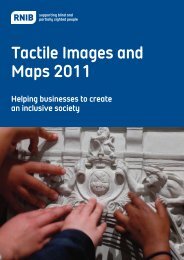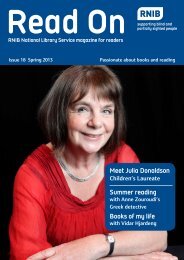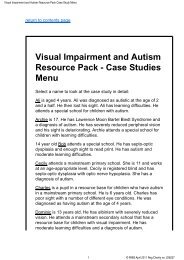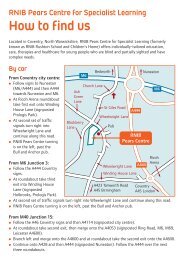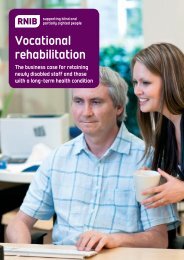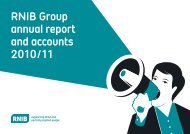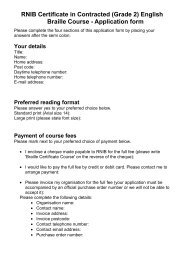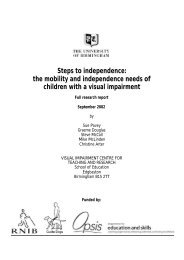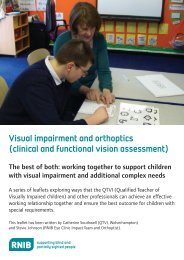Helping people find their lives again - RNIB
Helping people find their lives again - RNIB
Helping people find their lives again - RNIB
Create successful ePaper yourself
Turn your PDF publications into a flip-book with our unique Google optimized e-Paper software.
Structure and objectives<br />
Our legal structure<br />
The Royal National Institute of Blind People<br />
(<strong>RNIB</strong>) is a registered charity, number 226227<br />
in England and Wales; and number SCO39316<br />
in Scotland. Established in 1868, <strong>RNIB</strong> was<br />
incorporated under Royal Charter in 1949,<br />
with a Supplemental Charter in 1993 (revised<br />
in 2002).<br />
l<br />
l<br />
l<br />
l<br />
l<br />
l<br />
l<br />
l<br />
l<br />
Governance Committee<br />
Human Resources Sub-Committee<br />
Investments Sub-Committee<br />
Policy and Advocacy Committee<br />
Remuneration Committee<br />
<strong>RNIB</strong> Cymru Committee<br />
<strong>RNIB</strong> Northern Ireland Committee<br />
<strong>RNIB</strong> Scotland Committee<br />
Schools and Colleges Sub-Committee.<br />
<strong>RNIB</strong> is governed by a Trustee Board of 24<br />
that meets a minimum of six times a year and<br />
takes all important strategic, policy and<br />
financial decisions. The Board is supported by<br />
an Assembly consisting of representatives of<br />
stakeholder organisations, representatives<br />
from <strong>RNIB</strong>’s country governance structures<br />
and the wider <strong>RNIB</strong> membership. The purpose<br />
of the Assembly is to provide an opportunity<br />
to debate issues of importance to the<br />
organisation and to contribute to thinking in<br />
advance of decisions being made by the<br />
Board, allow the views of other organizations<br />
to be represented, elect members of<br />
committees, and elect 40 per cent of Board<br />
members.<br />
The revisions to the supplemental charter and<br />
bylaws required that a majority of the Trustee<br />
Board, Assembly and wider membership, are<br />
themselves blind or partially sighted.<br />
How we were managed<br />
During 2008/09 the Board was supported by<br />
a number of committees, the key ones of<br />
which were:<br />
l<br />
l<br />
l<br />
l<br />
l<br />
Access and Innovation Committee<br />
Audit Committee<br />
Direct Services Committee<br />
Executive Committee<br />
Fundraising Sub-Committee<br />
<strong>RNIB</strong>’s schools and colleges have <strong>their</strong> own<br />
governing bodies.<br />
The day-to-day management of <strong>RNIB</strong> is<br />
delegated to the Strategic Management Team,<br />
comprising the Chief Executive, and Group<br />
Directors of Access and Innovation; Devolved<br />
Services; Direct Services; Fundraising; Policy<br />
and Advocacy; and Resources.<br />
The Chief Executive, with the support of the<br />
Group Directors, reports to the Board of<br />
Trustees which approves major decisions and<br />
has overall responsibility for <strong>RNIB</strong>’s activities.<br />
Details of the Strategic Management Team can<br />
be found in the section “Who’s who in <strong>RNIB</strong>”.<br />
There are no restrictions on the way in which<br />
the charity can operate.<br />
<strong>RNIB</strong> Membership<br />
The aim of <strong>RNIB</strong>’s membership scheme is to<br />
bring an increasing number of blind and<br />
partially sighted <strong>people</strong> into a wider <strong>RNIB</strong><br />
community, so that they can receive<br />
information and support, and influence the<br />
priorities of <strong>RNIB</strong>.<br />
At March 2009 we had 10,400 members<br />
receiving the membership magazine “Vision”<br />
every two months and benefiting from<br />
services such as opportunities to meet other<br />
Structure and objectives 3


